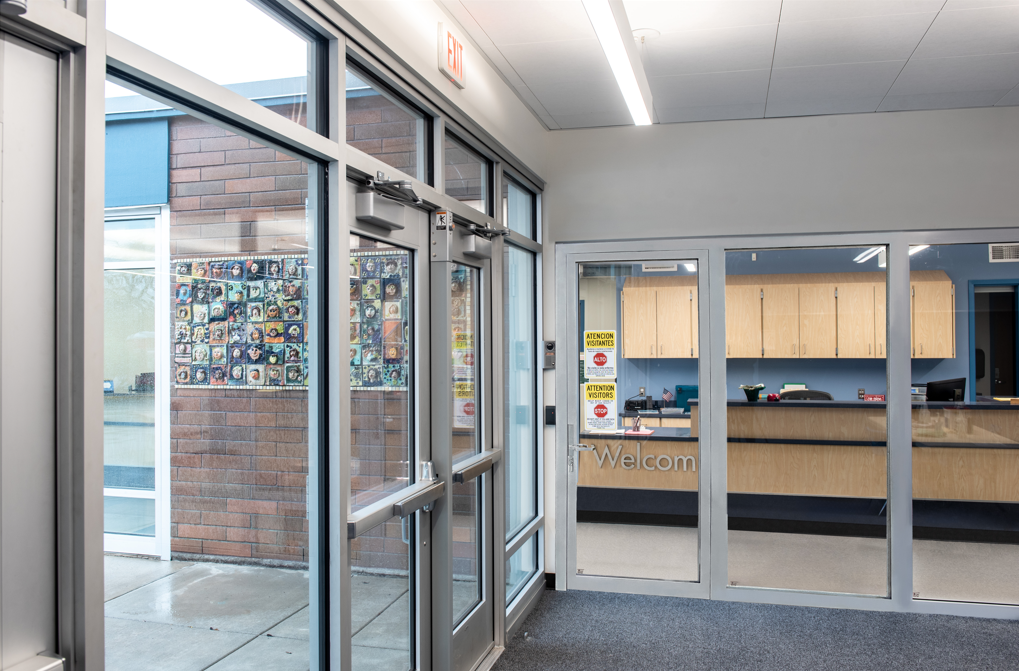Part of a system: how fire-resistant glazing plays a part in life-safety design

Life-safety design pertains to a building’s ability to protect its occupants from fire and other life-threatening emergencies. Many materials can contribute to life-safety designs, but some may limit an architect’s ability to create welcoming spaces through the introduction of natural light and open sightlines. Fire-resistant glazing can help designers achieve both by protecting occupants from fire, smoke and radiant heat without blocking views or inhibiting access to daylight.
In addition to guarding against fire, project owners may also seek other forms of protection, such as hardened exteriors or entry vestibules that resist forced-entry attack. While national model codes create standards that address emergencies like fire, there are currently no model code standards for using security-rated materials. It is important that specifiers understand how each form of protection affects the other—and how these materials support safety and well-being.
But how exactly does security- and fire-rated glazing help architects meet life safety design goals while also creating spaces that improve occupant experience?
Designing for life safety with fire-rated glass
Balancing occupant safety and well-being can be challenging. On the one hand, opaque materials can contribute to a seemingly impenetrable design. However, these materials also inhibit access to daylight and a sense of openness between adjacent spaces. On the other hand, transparent glazing can facilitate light-filled and open interiors. That said, non-rated glass can be seen as a weak point in both the building envelope and its interior. Security- and fire-rated glazing can solve this challenge. Not only can these materials guard occupants against threats to life-safety, but they also contribute to occupant well-being by enabling light-filled spaces with open sightlines.
When a project seeks protection against both fire and forced-entry, it is not as simple as combining a security-rated component and a fire-rated one. This can lead to unintended consequences to how the complete assembly performs. For instance, many security-rated products are plastic-based and can burn quickly and intensely, potentially exceeding testing parameters for fire resistance. This can essentially negate, or significantly reduce, an assembly’s fire rating, putting occupants at risk during a fire emergency.
But due to recent innovations, fire-resistant glazing can now provide another layer of protection—security. Fire-rated glazing assemblies are available with various security ratings, including forced-entry resistance and bullet resistance. These multifunctional, fire-rated systems are made from compatible components or have been tested as complete systems to multiple protocols. As such, they can be employed where design teams want to meet safety and security concerns without compromising the ability for the assembly to safeguard occupants from fire emergencies.
Additionally, whether an application needs to provide multiple forms of protection or only one, designers can meet their life safety design goals without sacrificing occupant comfort by choosing rated frames that have narrow-profiles. Not only do narrow-profile frames increase the area of glass in an assembly, but they can also provide a close visual match to adjacent, non-rated systems. They can be capped with different materials, further contributing to a cohesive design while maintaining code-driven life safety.
Beyond life safety: Enabling occupant well-being through open, light-filled spaces
Many researchers have underlined the relationship between natural light and mental well-being. Multifunctional, fire-resistive glazing systems can satisfy life safety designs while simultaneously promoting a more positive occupant experience. The glass in these systems allows daylight to stream deep into a building. It also allows occupants to see adjacent spaces, both inside and outside the built environment, increasing their sense of safety.
Related to a sense of safety, transparent, security- and fire-rated glass can reduce areas where occupants may be isolated. In a 2018 American Institute of Architects (AIA) survey, high school students indicated that openness between floors was a design trend they wanted to see implemented more often in schools. Their rationale was that visually open interiors can help reduce bullying and student-to-student intimidation.
Multifunctional, fire-rated glazing can also preserve transparency and fortify potential weak points in door and window openings. The glazing can enhance the effectiveness of an overall security plan by hardening entryways and exterior openings—all without compromising an assembly’s fire rating or its ability to contribute to a welcoming environment. When made with narrow-profile framing, these protective systems can blend seamlessly into the built environment, contributing to a cohesive design aesthetic. As such, they can be integral for linking voluntary security improvements with requisite fire- and life-safety design goals in several occupancy types.
Putting the "life" in life safety design
Whether meeting life safety design goals involves fire-resistant materials or ones that provide multiple forms of protection, it is important these materials also contribute to a welcoming environment. Though threats to life safety are a real and present danger, they represent a small (but critical) fraction of a building’s service life. The vast majority of days and hours within a building will most likely be uneventful, making it equally important that security- and fire-rated materials also contribute to occupant comfort.


 Devin Bowman is General Manager of Technical Glass Products (TGP) and AD Systems. With nearly 20 years of industry experience, Bowman is actively involved in advancing fire- and life-safety codes and sits on the Glazing Industry Code Committee (GICC).
Devin Bowman is General Manager of Technical Glass Products (TGP) and AD Systems. With nearly 20 years of industry experience, Bowman is actively involved in advancing fire- and life-safety codes and sits on the Glazing Industry Code Committee (GICC).